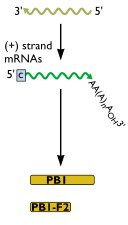

The PB1-F2 protein is not produced in cells infected with the 2009 H1N1 strain because there are three translation stop codons at nucleotide positions 12, 58, and 88. To determine if this protein plays a role in virulence, the second RNA segment of the A/California/04/2009 H1N1 strain was genetically altered to code for a full-length PB1-F2 protein. When mice or ferrets were infected intranasally with the modified virus, no significant differences in symptoms of infection were observed compared with mice infected with Cal/09 virus. The parameters measured included weight loss, viral replication in the lungs, and lung pathology.
The PB1-F2 protein has been shown to increase the severity of primary viral and secondary bacterial infections in mice. However, no increased mortality was observed in mice co-infected with Streptococcus pneumoniae and Cal/09 virus that can produce PB1-F2 protein.
Some differences were observed that might be attributed to the production of PB1-F2 protein. Synthesis of this protein was associated with enhanced replication in a human respiratory cell line. Furthermore, mice infected with the modified virus produced higher levels of some pro-inflammatory cytokines than mice infected with Cal/09 virus. The significance of these observations is unclear. Higher levels of virus production can influence transmission of infection among hosts, but the effect of PB1-F2 on this property was not examined. While increased proinflammatory cytokines could exacerbate or ameliorate disease, there was no effect on pathogenesis in mice.
The authors conclude that mutations enabling the production of PB1-F2 in the Cal/09 influenza virus do not have a significant impact on virus virulence in mice or in ferrets. Whether similar results would be observed in humans is unknown. But not all PB1-F2 proteins are the same: that produced by the genetically altered Cal/09 virus is different from the protein made by the 1918 H1N1 virus. It would be interesting to determine if the nature of the PB1-F2 protein has any effect on the virulence of the 2009 pandemic virus.
Hai, R., Schmolke, M., Varga, Z., Manicassamy, B., Wang, T., Belser, J., Pearce, M., Garcia-Sastre, A., Tumpey, T., & Palese, P. (2010). PB1-F2 expression by the 2009 pandemic H1N1 influenza virus has minimal impact on virulence in animal models Journal of Virology DOI: 10.1128/JVI.02717-09

Comments are closed.